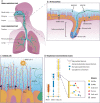Defensive Properties of Mucin Glycoproteins during Respiratory Infections-Relevance for SARS-CoV-2
- PMID: 33184103
- PMCID: PMC7663010
- DOI: 10.1128/mBio.02374-20
Defensive Properties of Mucin Glycoproteins during Respiratory Infections-Relevance for SARS-CoV-2
Abstract
Mucus plays a pivotal role in protecting the respiratory tract against microbial infections. It acts as a primary contact site to entrap microbes and facilitates their removal from the respiratory tract via the coordinated beating of motile cilia. The major components of airway mucus are heavily O-glycosylated mucin glycoproteins, divided into gel-forming mucins and transmembrane mucins. The gel-forming mucins MUC5AC and MUC5B are the primary structural components of airway mucus, and they enable efficient clearance of pathogens by mucociliary clearance. MUC5B is constitutively expressed in the healthy airway, whereas MUC5AC is upregulated in response to inflammatory challenge. MUC1, MUC4, and MUC16 are the three major transmembrane mucins of the respiratory tracts which prevent microbial invasion, can act as releasable decoy receptors, and activate intracellular signal transduction pathways. Pathogens have evolved virulence factors such as adhesins that facilitate interaction with specific mucins and mucin glycans, for example, terminal sialic acids. Mucin expression and glycosylation are dependent on the inflammatory state of the respiratory tract and are directly regulated by proinflammatory cytokines and microbial ligands. Gender and age also impact mucin glycosylation and expression through the female sex hormone estradiol and age-related downregulation of mucin production. Here, we discuss what is currently known about the role of respiratory mucins and their glycans during bacterial and viral infections of the airways and their relevance for the novel coronavirus severe acute respiratory syndrome coronavirus 2 (SARS-CoV-2). Understanding the impact of microbe-mucin interaction in the respiratory tract could inspire the development of novel therapies to boost mucosal defense and combat respiratory infections.
Keywords: MUC1; O-linked glycans; SARS-CoV-2; glycosylation; mucin; mucin-microbe interactions; mucosal barrier; respiratory pathogens.
Copyright © 2020 Chatterjee et al.
Figures

Similar articles
-
Glycosylated extracellular mucin domains protect against SARS-CoV-2 infection at the respiratory surface.PLoS Pathog. 2023 Aug 10;19(8):e1011571. doi: 10.1371/journal.ppat.1011571. eCollection 2023 Aug. PLoS Pathog. 2023. PMID: 37561789 Free PMC article.
-
Mucins: the frontline defence of the lung.Biochem Soc Trans. 2018 Oct 19;46(5):1099-1106. doi: 10.1042/BST20170402. Epub 2018 Aug 28. Biochem Soc Trans. 2018. PMID: 30154090 Free PMC article. Review.
-
Heterogeneity of airways mucus: variations in the amounts and glycoforms of the major oligomeric mucins MUC5AC and MUC5B.Biochem J. 2002 Feb 1;361(Pt 3):537-46. doi: 10.1042/0264-6021:3610537. Biochem J. 2002. PMID: 11802783 Free PMC article.
-
MUC5B mobilizes and MUC5AC spatially aligns mucociliary transport on human airway epithelium.Sci Adv. 2022 Nov 25;8(47):eabq5049. doi: 10.1126/sciadv.abq5049. Epub 2022 Nov 25. Sci Adv. 2022. PMID: 36427316 Free PMC article.
-
Role of epithelial mucins during airway infection.Pulm Pharmacol Ther. 2012 Dec;25(6):415-9. doi: 10.1016/j.pupt.2011.12.003. Epub 2011 Dec 17. Pulm Pharmacol Ther. 2012. PMID: 22198062 Free PMC article. Review.
Cited by
-
Cellular metabolic basis of altered immunity in the lungs of patients with COVID-19.Med Microbiol Immunol. 2022 Feb;211(1):49-69. doi: 10.1007/s00430-021-00727-0. Epub 2022 Jan 13. Med Microbiol Immunol. 2022. PMID: 35022857 Free PMC article.
-
The therapeutic potential of inorganic polyphosphate: A versatile physiological polymer to control coronavirus disease (COVID-19).Theranostics. 2021 Apr 15;11(13):6193-6213. doi: 10.7150/thno.59535. eCollection 2021. Theranostics. 2021. PMID: 33995653 Free PMC article. Review.
-
Transcriptional Profiling and Genetic Analysis of a Cystic Fibrosis Airway-Relevant Model Shows Asymmetric Responses to Growth in a Polymicrobial Community.bioRxiv [Preprint]. 2023 May 24:2023.05.24.542191. doi: 10.1101/2023.05.24.542191. bioRxiv. 2023. Update in: Microbiol Spectr. 2023 Sep 29:e0220123. doi: 10.1128/spectrum.02201-23. PMID: 37293107 Free PMC article. Updated. Preprint.
-
The Interplay between Airway Cilia and Coronavirus Infection, Implications for Prevention and Control of Airway Viral Infections.Cells. 2024 Aug 14;13(16):1353. doi: 10.3390/cells13161353. Cells. 2024. PMID: 39195243 Free PMC article. Review.
-
Breaking Down the Bottlebrush: Atomically Detailed Structural Dynamics of Mucins.J Chem Inf Model. 2024 Oct 28;64(20):7949-7965. doi: 10.1021/acs.jcim.4c00613. Epub 2024 Sep 27. J Chem Inf Model. 2024. PMID: 39327869 Free PMC article.
References
-
- Fernández-Blanco JA, Fakih D, Arike L, Rodríguez-Piñeiro AM, Martínez-Abad B, Skansebo E, Jackson S, Root J, Singh D, McCrae C, Evans CM, Åstrand A, Ermund A, Hansson GC. 2018. Attached stratified mucus separates bacteria from the epithelial cells in COPD lungs. JCI Insight 3:e120994. doi:10.1172/jci.insight.120994. - DOI - PMC - PubMed
Publication types
MeSH terms
Substances
LinkOut - more resources
Full Text Sources
Other Literature Sources
Research Materials
Miscellaneous

